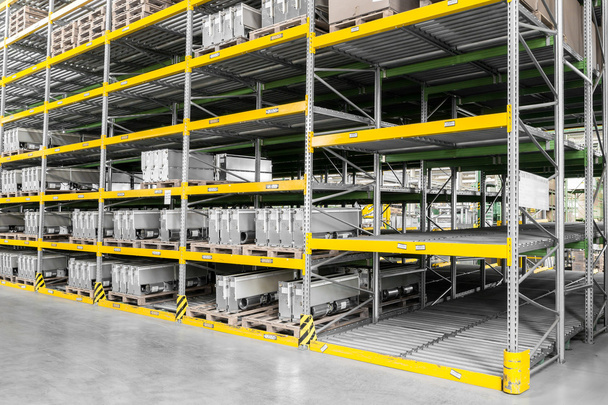
Are you in need of extra storage space? Learn how to build pallet racking in just a few simple steps. With the right materials and a little bit of effort, you can create a sturdy and practical storage solution for your home or business.
In this article, we will guide you through the process of:
- Preparing the workspace
- Building the frame
- Installing the shelves
- Securing and finishing the racking
Let’s get started!
Key Takeaways
- The workspace should be cleared of obstructions and hazards, and debris should be removed to ensure a safe working environment.
- The frame of the pallet racking should be built using heavy-duty steel upright frames and horizontal beams, with diagonal braces added for stability.
- The shelves should be selected and positioned on the frame, ensuring they are level and evenly spaced. Safety pins should be used to secure the shelf beams.
- The racking should be properly secured and reinforced, and additional safety features such as corner guards or rack protectors can be added. A finishing touch of paint or protective finish can enhance the appearance and durability of the racking.
Materials Needed

To build pallet racking, you’ll need certain materials.
First and foremost, you’ll need upright frames, which serve as the vertical support for the racking system. These frames are typically made of heavy-duty steel and come in various heights to accommodate different storage needs.
Additionally, you’ll need horizontal beams, which connect the upright frames and provide the shelves for storing pallets. These beams are usually adjustable, allowing you to customise the height of each shelf based on your requirements.
Other essential materials include wire mesh decking, which provides a stable surface for storing non-palletizer items, and safety clips to secure the beams to the frames.
Lastly, don’t forget about the necessary hardware, such as nuts, bolts, and anchors, to ensure the stability and integrity of the pallet racking system.
Preparing the Workspace
Before you begin building pallet racking, clear the workspace and make sure it’s free from any obstructions or hazards. This step is crucial to ensure a safe and efficient construction process.
Start by removing any tools, equipment, or materials that aren’t needed for the project. Clear away any debris or clutter that could pose a tripping or falling hazard. Check the area for any loose wires, nails, or sharp objects that could cause injury.
If necessary, sweep or mop the floor to remove any dust or dirt. By taking the time to prepare the workspace, you’ll create a clean and organised environment that will make the construction process much easier and safer.
Building the Frame
First, gather the necessary materials and tools for building the frame of the pallet racking. You’ll need uprights, beams, braces, and bolts. Make sure you have a tape measure, level, wrench, and hammer on hand as well.
Start by attaching the uprights to the floor using anchor bolts. Use the tape measure and level to ensure they’re straight and aligned properly.
Next, connect the beams to the uprights, using bolts to secure them tightly.
Add braces diagonally between the uprights for added stability.
Double-check that everything is level and secure before moving on to the next step.
Building the frame is crucial for the stability and strength of the pallet racking system.
Installing the Shelves
To properly install the shelves for your pallet racking system, begin by selecting the appropriate size and type of shelving. This step is crucial as it ensures that your shelves will be able to support the weight of your stored items and fit seamlessly within the racking system.
Once you have chosen the right shelves, follow these steps to install them effectively:
- Position the shelf beams: Place the shelf beams on the upright frames, making sure they’re level and evenly spaced. Use a level to ensure accuracy.
- Secure the beams: Once the beams are in position, secure them by inserting the safety pins into the beam connectors. These pins provide added stability and prevent the beams from accidentally dislodging.
- Test the stability: After installing all the shelves, give them a gentle shake to test their stability. If any shelves feel wobbly or insecure, double-check the installation and make necessary adjustments.
Securing and Finishing the Racking
To secure and finish the racking for your pallet system, you’ll need to follow a few key steps.
First, make sure all the shelves are properly installed and secured. Check that they’re level and stable to prevent any accidents or damage.
Next, use appropriate hardware, such as bolts or screws, to reinforce the connections between the shelves and the uprights. This will provide additional stability and support for your racking system.
Additionally, consider adding safety features, such as corner guards or rack protectors, to protect the racking from forklift collisions.
Lastly, don’t forget to finish the racking with a coat of paint or a protective finish to enhance its appearance and durability.
Following these steps will ensure that your pallet racking is secure and ready for use.
Frequently Asked Questions
How Much Weight Can a Pallet Racking System Support?
A pallet racking system can support a significant amount of weight. It depends on various factors such as the type of racking, the configuration, and the quality of materials used.
Can Pallet Racking Be Used in a Cold Storage Facility?
Yes, pallet racking can be used in a cold storage facility. It’s important to choose the right type of racking that can withstand low temperatures and ensure the safety of your storage operations.
What Are the Safety Precautions to Consider When Using a Pallet Racking System?
When using a pallet racking system, you should prioritise safety. Ensure the racks are properly installed and secure. Regularly inspect for damage or wear. Train employees on proper loading and unloading techniques to prevent accidents.
Can Pallet Racking Be Easily Disassembled and Reconfigured in a Different Layout?
Yes, pallet racking can be easily disassembled and reconfigured in a different layout. You just need to follow the proper steps and precautions to ensure a smooth transition without compromising its structural integrity.
Are There Any Specific Regulations or Guidelines That Need to Be Followed When Installing Pallet Racking in a Commercial Space?
When installing pallet racking in a commercial space, it is important to follow specific regulations and guidelines. These ensure the safety and stability of the racking system, preventing accidents and damage.
